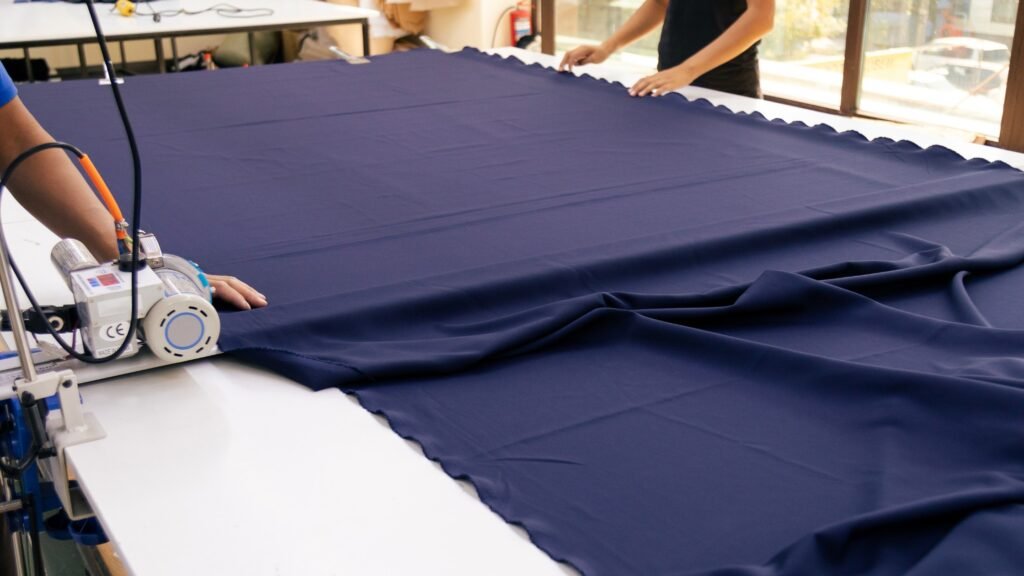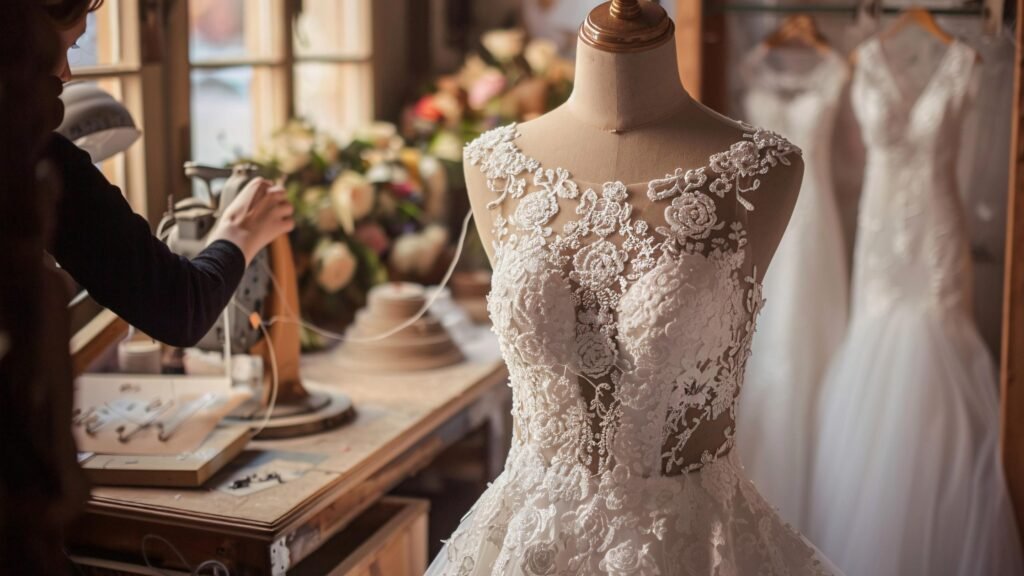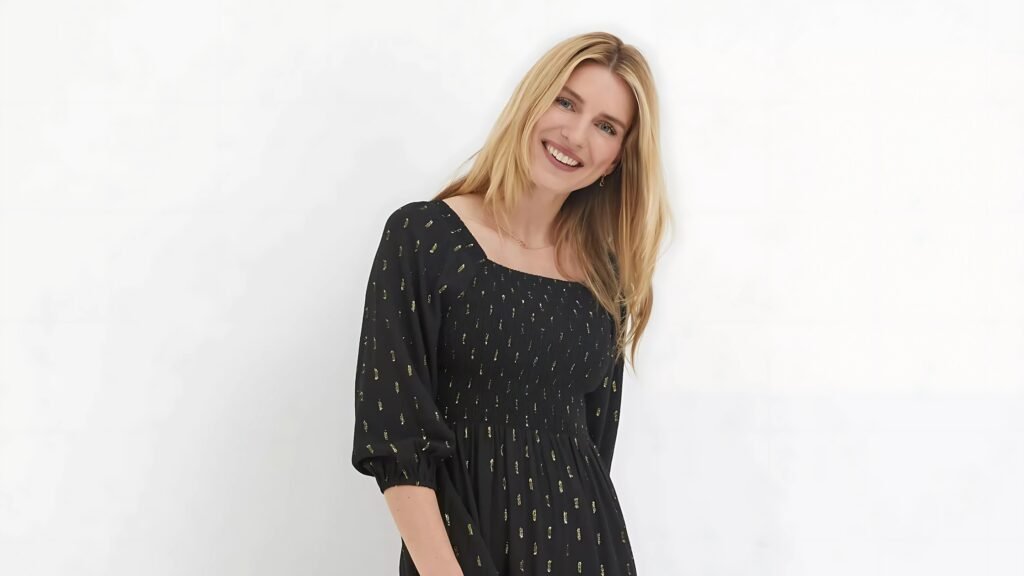Creating a custom garment is a dynamic and intricate process, blending artistic vision with technical expertise.
It all begins with a simple idea or sketch, and from there, the journey involves several key stages of development, testing, and refinement before the final product reaches the customer.
Whether it’s a bespoke suit, a branded fashion collection, or a high-end bridal gown, the journey of a custom garment requires collaboration, precision, and high-quality manufacturing.
In this blog, we will take you through the exciting journey of a custom garment, from the initial sketch to the final stitch.
We will also explore how Kanika Global plays a pivotal role in bringing your custom designs to life, ensuring the highest standards of quality, craftsmanship, and innovation throughout the process.
1. The Design Phase: From Concept to Sketch

The journey of a custom garment begins with an idea. Designers, whether they are independent creators or part of a larger brand, sketch their visions on paper or create digital renderings to bring their ideas to life.
This phase is all about creativity and ensuring that the design concept aligns with the target audience and brand identity.
- Initial Design Brief: This is the foundational step where designers outline the key aspects of the garment, including fabric choice, fit, and silhouette.
- Sketching the Idea: Designers create detailed sketches of the garment, capturing the shape, proportions, and design details such as buttons, zippers, and stitching patterns.
For Kanika Global, the design phase is crucial because it sets the foundation for all the subsequent stages. Kanika Global’s experienced team of designers works closely with clients to understand their vision and create accurate tech packs that will guide the production process.
Kanika Global supports brands by providing expert guidance and turning design sketches into production-ready files, ensuring that the original concept is maintained through every step of the process.
2. Pattern Making: Translating the Design into a Template

Once the sketch is finalized, the next step is pattern making. This is where the garment design is translated into a physical template that will be used to cut the fabric.
The pattern-making process is essential because it determines how the garment will fit, feel, and flow.
- Creating the Master Pattern: Skilled pattern makers take the design sketch and develop a master pattern using specialized tools. This pattern serves as the template for cutting the fabric.
- Grading the Pattern: For garments that will be produced in multiple sizes, the pattern must be graded to adjust for different measurements while maintaining the garment’s proportions and fit.
- Mock-ups and Toile: A mock-up garment, often made from inexpensive fabric (called a toile), is created to test the fit and design. This allows for any necessary adjustments before the actual garment is cut from high-end fabrics.
At Kanika Global, the pattern-making process is executed with precision and expertise. Kanika Global has a dedicated team of pattern makers who ensure that each design is accurately translated into a production-ready template.
By working closely with designers, Kanika Global guarantees that every garment, no matter how complex, is created to fit perfectly and reflect the original vision.
3. Fabric Selection: Choosing the Right Materials

Choosing the right fabric is one of the most critical steps in the journey of a custom garment. The fabric not only defines the garment’s aesthetic but also impacts its durability, comfort, and functionality.
Depending on the design and intended use of the garment, the fabric must be selected with care.
- Fabric Sourcing: Designers work with fabric suppliers to choose materials that meet the design’s aesthetic and functional requirements. Whether it’s luxurious silk, breathable cotton, or eco-friendly fibers, fabric selection is key.
- Fabric Testing: Once the fabric is chosen, it undergoes testing for colorfastness, durability, shrinkage, and feel. This step ensures that the fabric performs well over time.
At Kanika Global, the team is committed to high-quality fabric sourcing. With an extensive network of trusted suppliers, Kanika Global ensures that every custom garment is made with the finest materials.
The company also prioritizes sustainable fashion, offering a range of eco-friendly and organic fabrics to meet the growing demand for sustainability in fashion.
Kanika Global’s focus on using premium, sustainable materials ensures that every garment produced not only meets high aesthetic standards but also aligns with ethical and environmental values.
4. Cutting the Fabric: Precision and Accuracy

Once the fabric has been chosen, it’s time to cut the material according to the pattern. This stage requires precision, as even slight inaccuracies can affect the fit and appearance of the final garment.
- Cutting the Fabric: The fabric is layered and then cut using industrial cutting machines or manual techniques, depending on the complexity of the design.
- Marking and Notching: Special markings are made on the fabric to guide the assembly process. These markings include notches that show where pieces should be sewn together.
At Kanika Global, cutting is done with the utmost precision. The cutting team at Kanika Global ensures that each piece of fabric is cut accurately, following the pattern and design specifications.
The company uses advanced cutting technology that allows for minimal waste, enhancing both the efficiency and sustainability of the production process.
5. Stitching: Bringing the Design to Life

The next step is stitching, where the fabric pieces are sewn together to create the garment. This phase is where the design truly starts to take shape.
Skilled seamstresses and technicians ensure that the fit and design details are maintained while sewing the pieces together.
- Assembly: The fabric pieces are sewn according to the pattern, ensuring that each stitch is placed perfectly.
- Design Details: This is where buttons, zippers, and embellishments are added, and finishing touches such as hemming and topstitching are completed.
At Kanika Global, the stitching process is carried out with expert craftsmanship. The brand’s commitment to high-quality manufacturing means that every stitch is carefully executed to meet the exact design specifications.
Kanika Global uses state-of-the-art sewing machines to ensure that every garment is both durable and beautifully constructed.
6. Fitting and Adjustments: Perfecting the Custom Fit

Once the garment is assembled, it is time for the fitting. This is where any necessary adjustments are made to ensure the garment fits perfectly and matches the original design.
- Fit Sessions: A fit model or mannequin is used to test the garment’s fit and proportions. This allows designers and technicians to make adjustments to ensure the garment fits as intended.
- Final Tweaks: If the garment requires minor changes, adjustments are made to the seams, buttons, or zippers to enhance fit, comfort, and appearance.
At Kanika Global, fit testing is an integral part of the production process. The company offers custom garment fittings to ensure that each piece is perfect before it is finalized.
Whether it’s adjusting the waistline on a pair of trousers or modifying the neckline of a dress, Kanika Global ensures that every garment is a perfect fit for the customer.
7. Final Inspection: Ensuring Quality

Before the garment is shipped out, it undergoes a final inspection to ensure that it meets all quality standards.
This step includes checking the stitching, fabric, design details, and overall craftsmanship.
- Quality Control: The final garment is checked for any imperfections or defects that may have occurred during the production process.
- Packaging: Once the garment passes inspection, it is carefully packaged and prepared for delivery to the customer or retail partner.
At Kanika Global, the final inspection is thorough and meticulous. The company ensures that every custom garment that leaves their facility is of the highest quality, with no detail overlooked.
Kanika Global uses strict quality control standards, ensuring that customers receive only the best.
Final Thoughts: Bringing Your Custom Garment to Life with Kanika Global

The journey of a custom garment is a delicate balance between creativity and craftsmanship. From the initial sketch to the final stitch, every step requires expertise, attention to detail, and a commitment to quality.
At Kanika Global, we understand the importance of each stage of this process and work tirelessly to bring your custom garment to life with precision and care.
Whether you’re designing a bespoke collection or launching a new fashion line, Kanika Global offers the expertise, resources, and commitment to excellence needed to ensure your custom garments meet the highest standards.
With a focus on quality craftsmanship, sustainable fashion, and ethical production, Kanika Global is your trusted partner in bringing your designs from sketch to stitch.
FAQs
Q1: What is a custom garment?
A custom garment is a piece of clothing that is designed and produced according to a client’s specific requirements. From the fabric and design details to the fit and finish, every aspect of a custom garment is tailored to the client’s preferences. Kanika Global specializes in creating custom garments with precision, ensuring that every piece meets the highest standards of craftsmanship.
Q2: How long does it take to create a custom garment?
The timeline for creating a custom garment can vary depending on the complexity of the design, fabric availability, and production schedule. Typically, the process can take anywhere from a few weeks to a few months. At Kanika Global, we offer a streamlined and efficient process while ensuring that every garment is crafted to perfection without compromising quality.
Q3: Can I make adjustments to my custom garment after the fitting session?
Yes, after the fitting session, any necessary adjustments can be made to ensure that the garment fits perfectly and matches the original design. At Kanika Global, we work closely with clients to make final tweaks to the custom garment, whether it involves adjusting the fit, altering design details, or enhancing comfort.
Q4: What kind of fabrics are used in custom garments?
The fabric chosen for a custom garment depends on the design, intended use, and the client’s preferences. Kanika Global offers a wide range of high-quality fabrics, including luxurious silks, breathable cottons, and eco-friendly materials. We also prioritize sustainable fashion, offering a range of organic fabrics that align with ethical and environmental values.


